Kenosha after the Rittenhouse verdict - calm in the eye of the storm
The day after the jury found Kyle Rittenhouse not guilty of all charges related to him killing two people and wounding a third, I took the 12:51 PM train to Kenosha, not sure what to expect.
I wasn’t expecting the kind of rioting and looting that rocked Kenosha in the wake of the shooting of Jacob Blake, which inspired Rittenhouse to drive to the city and play vigilante. I agreed with several other journalists that mentioned on Twitter that the weather was way too cold for this kind of thing. But I figured there might be protests. And, honestly, I was curious if we might see something like the mass painting of murals on the plywood I saw when I went to Kenosha on Aug. 28, 2020, three days after Rittenhouse shot three people and five days after Blake was shot. That came as a complete, albeit pleasant surprise to me at the time.
I’ve blogged about that visit, and the visit in October of the same year. Since then, I’ve been to Kenosha in March of this year and in the end of May. I saw more and more plywood come down. In March, I read an article in Kenosha News I got at Kroger’s about how the city really wanted businesses to take the plywood down, and saw in the end of May that, while most did, a few didn’t. In those two times - it wasn’t as if the events of last summer, of the then-upcoming Rittenhouse trial, weren’t on people’s minds, but it wasn’t what people focused on. I was curious how people were feeling now, when at least one chapter of this saga is over.
Some words about my feelings on the verdict. I wasn’t able to follow the trial as closely as I would’ve liked - I still have work, and writing of the creative kind - but, from what I’ve seen and read, I thought the prosecution didn’t make the best case. And there the fact that Wisconsin law, like the law in some other states, allows people to brandish firearms who have no business brandishing firearms, and gives too much leeway to people claiming self-defense. Two people died, one of whom was unarmed. There have to be consequences for that. Maybe not life in prison type consequences, but consequences nonetheless.
I’ve heard some variation of the statement that this would have played out differently if Rittenhouse was black, and I think there is something to it, in the sense that, one of the things covering majority-black neighborhoods taught me was we as the American society more readily assume danger when it comes to Black men, even Black kids, the way we don’t necessarily do with white kids. An African-American teen brandishing a rifle would’ve gotten more concern, I doubt police would’ve been allowed him to just walk away and I think the jury would’ve been less inclined to see him as a scared kid fighting for his life.
I wanted to go to Kenosha on Friday, when the verdict was announced, but Metra Union Pacific North Line schedule, which already didn’t have that many trips to Kenosha, only got worse since my last visit. The only way to get to Kenosha now is to take an early morning train, and the only evening train returning to Chicago is earlier than ever. But Saturday schedule, which was restored at the end of May, is still more flexible in that regard. I still managed to miss an earlier morning train, but at least the Saturday schedule had a noon option.
Like I said, I expected that there might be a protest, maybe a rally, maybe a handful of protesters at the courthouse. But that’s not what I found in Kenosha.
The closest thing to normal
As the train entered Kenosha, I noticed that the site of the Kenosha Department of Corrections building that got torched during the riots was still vacant, long after the debris were removed - though, by the looks of things, someone could be preparing the site for construction.

The 56th Street, where the Kenosha County Courthouse (where Rittenhouse was tried) city and county law enforcement officers are located, where, back in Aug. 28, 2020, they had barricades and fenced-off blocks, looked calm. The fact that it was empty wasn't that terribly unusual for a Saturday.

The few other people on the train didn't look like they were heading there to protest or anything like that

Outside the station, there was no heightened security or anything like that. And, while you can't tell from this photo (unless you blow it up and look really, really closely), I noticed a Kenosha streetcar coming down the track a few blocks away. An African-American family with three kids were sitting at the nearby streetcar stop, and the younger kids grumbled about when the streetcar was going to get there, already.

As I mentioned before, Kenosha Streetcar is really more of a tourist attraction, a fun way to see downtown, than anything you would take to get to work. I wouldn't be surprised if they came from either Chicago or Milwaukee just to ride it. The fact that the city kept the streetcar running, and that the family wasn't concerned, said a lot.

In fact, I quickly realized that the Wisconsin Coach intercity bus (which links together Kenosha, Racine and Milwaukee) and local Kenosha Area Transit buses were running without any issues. Down the street, people were doing some streetscaping work, but they didn’t impede the streetcar any.
I figured that the Civic Center Park, which is located across the street from the Kenosha County Courthouse, was the logical destination. If there were going to be any rallies or protests, this would be the logical place. Instead, what I saw was a lot of television equipment

And TV reporters using the courthouse as a backdrop.
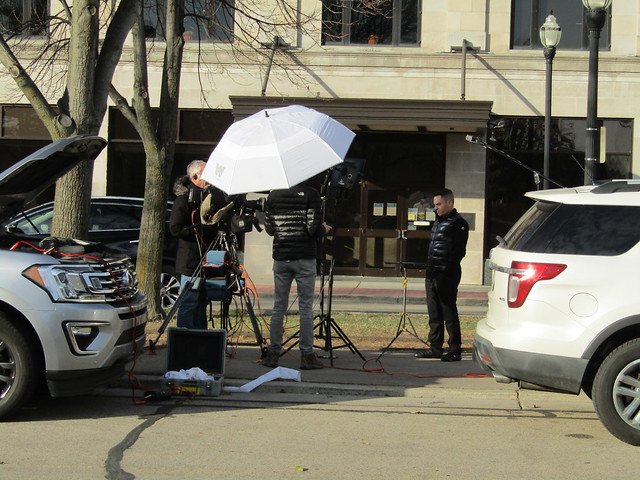
Further south on Civic Center Park, I saw a large tent, and camera crew bringing in equipment. I asked one of the crew members if there was some kind of press conference happening, but he just shrugged and said that that they were just there to film live reports.

The courthouse itself looked the same as it did in the end of May…

…except for all the no-parking signs on both sides of the street

The only people I saw who might have been interested in rallying were these guys, but even then, I'm not sure (and I didn't ask)

Someone did put up a leaflet on the Civic Center Park sign denouncing the judge who presided over the Rittenhouse case

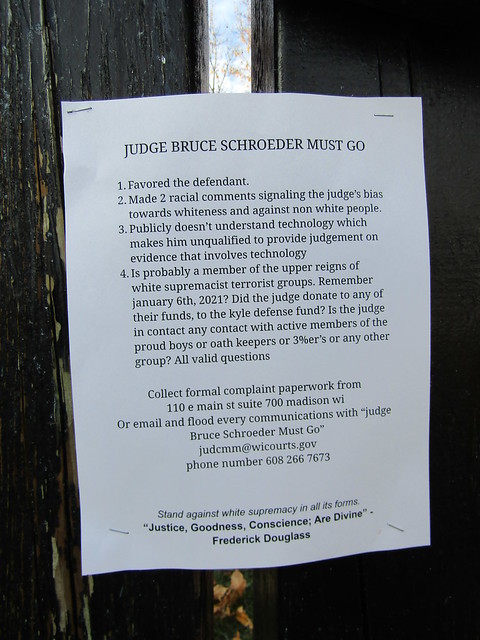
As I walked around Kenosha, I found myself thinking that, in some ways, the city feels closer to "normal" than ever. Several big murals that were there in the end of May, including the one painted on the Ultimate Convenience Center gas station convenience store…


…is gone
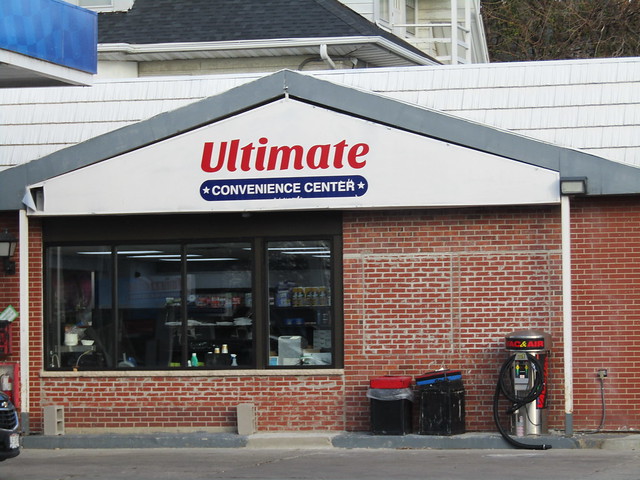
Car Source auto dealership lot, which got torched during the riots and still reeked of burned gasoline three days later…
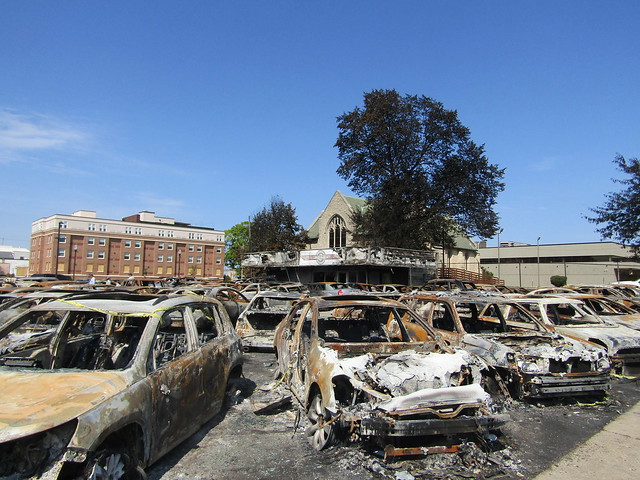
…Looks mostly as good as new.
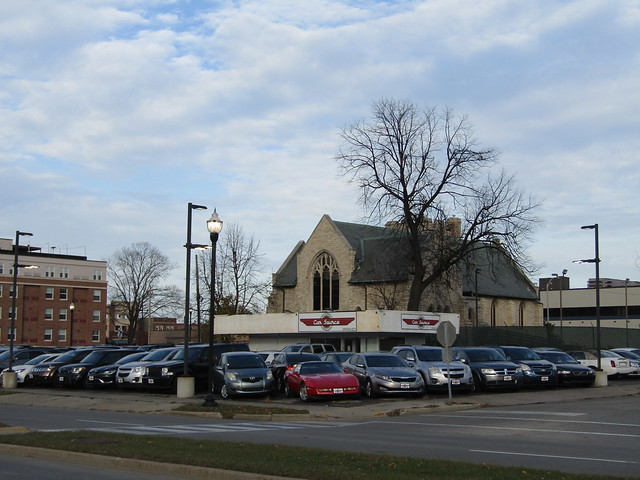
While I wondered if some of the businesses might close due to concern about the riots - Blue House Books bookstore cancelled a holiday party on the day of the verdict, “not because I believe there will be any violence getting out of hand, but because I understand some of our customers are anxious about coming downtown and I don’t want anyone to miss out on the fun” - nothing of the sort happened. A thrift store closed because the owner was at an estate sale and one clothing store closed a little earlier that day, but that’s it.

Since I was last in Kenosha, Blue House Books moved to a new, larger space (when I looked through my photo archive, I discovered that the space was previously an insurance company, out of all things).

I liked the new location. It had some nice interiors, and it made me realize just how crammed the original location felt. “I’m starting to run out of room again,” the owner told one of the customers.

As I browsed, I overheard her talking to what sounded like her old friends, who came down form Madison, about how they got a lot of customer traffic an hour or so earlier. And I wasn’t the only customer even then. If people might have been inclined to stay away on Friday, that sure wasn’t the case on Saturday.
(In an amusing aside, I heard a bit of a conversation with another customer, and she mentioned something about how she saw a book on Amazon. The owner responded with the “that’s nice” that sounded like “oh, so I guess you’re going to buy it on Amazon,” but the customer quickly disabused her of that notion.
“Amazon already pays me,” the customer said. “They’re not getting any of that money back.”
(For context - Kenosha is home to a major Amazon distribution and delivery hub))
The Buzz café (the one where I got the ginormous cinnamon bun) was filled with crowds, and so were many other businesses. Later, when it got dark, I saw a photographer talking pictures of a woman against the background of lit-up, plywood-free storefronts.
And yet, the signs of last year’s events were still there. Just to the east of the Civic Center Park, some buildings I walked past to on the way to the Car Source lot still had plywood, and murals.

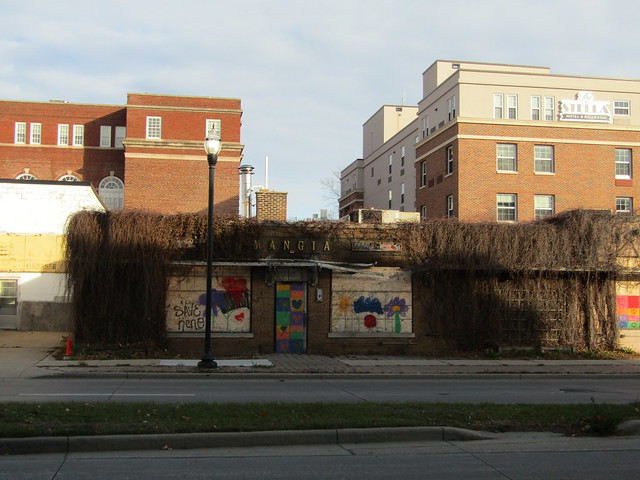
And so did the retail building directly south of the gas station.

I saw a few men walking around it, and I’m still not sure whether they were putting the plywood up or getting ready to take it down.
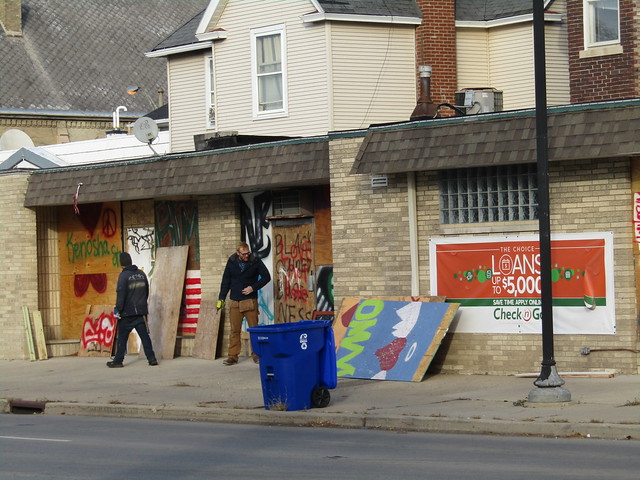
I ended up walking further south on Sheridan Road than ever before, and came across this house

Across the street from Blue House Books, somebody put up a whole bunch of plywood - old plywood, but clearly different plywood than what was there last August.

Last time I was in Kenosha, I saw “please don’t take this down” signs on two storefronts worth of plywood. The signs are gone, but the plywood is still there.
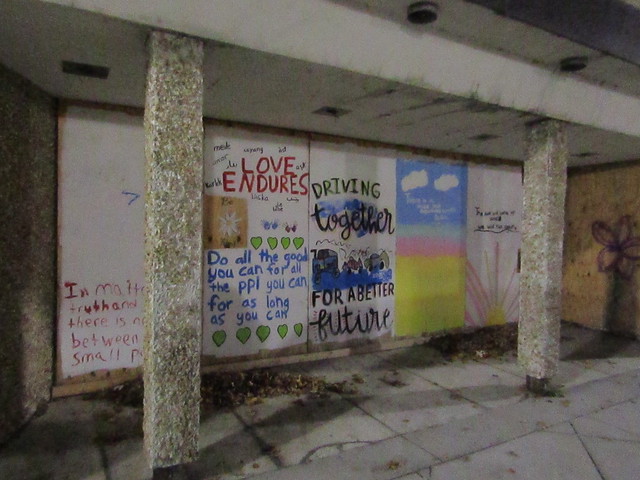
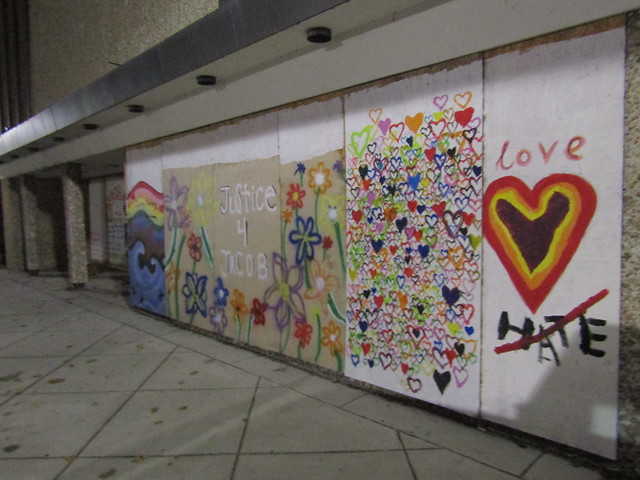
A little north of downtown, Red Speed Copies clearly had fresh plywood. The small sign by the door explained that the business was open.

I went to grab late lunch at Trolley Dogs fast food eatery. As I waited for my order, two local cops - a Black man and a white woman - walked in to grab some fast food. The customers were a racially mixed crowd, and nobody really batted much of an eye. And I found myself thinking about how were wearing bulletproof vests and body cameras. I’m not sure about bulletproof vests, but Kenosha police officers didn’t start wearing body cameras until April 2021.

Later, when it was dark, I ran across a reminder of another police shooting related controversy that gained new relevance after what happened with Jacob Blake.

As I headed back toward the Metra station, I saw one reporter making one final report across the street from the Kenosha County Courthouse.

In the end, there were no protests in Kenosha the day after the verdict. There were protests hours after the verdict, there were protests the day after the verdict. Those two days saw protests in Milwaukee, Chicago, Portland, New York City, Oakland, San Diego and Los Angeles, but in Kenosha… all was calm on the streets of Kenosha.
The city did see a protest on Sunday. It was peaceful. Filled with, to borrow a Soviet phrase, righteous indignation, but peaceful.
And, in a bit I found out just today, an armed father and daughter, both Black, walked with the protesters, to protect them.
After the the national spotlight
A few hours after the Rittenhouse verdict was announced, Deneen Smith, a long-time Kenosha News reporter who covered the trial, tweeted about how she felt that out-of-town news outlets went a bit overboard covering the riot damage, making it sound “like it’s a frightening wasteland instead of a lovely little city.” And I get how she was feeling. It’s not like she was saying that people shouldn’t report on the bad parts - as she noted elsewhere in that thread, she reported on a lot of that herself. But she knows the city - the good, the bad and he ugly. If there is one thing that my work has taught me, over and over again, is that every community has its own little nuances, its own regional specifics, and everything is tied to the historical context of what came before, sometimes going back years, sometimes going back decades. And a reporter who’s been covering a place for decades has the finger on the pulse of the community, the sense of all those little nuances, that someone coming out of town for this one thing can never hope to have.

I’ve been visiting Kenosha since I was in college, so I have a bit more context about the city than some of the reporters - but I would never imagine I know anywhere as much as reporters like Smith.
I report on the Chicago West Side communities like Austin and North Lawndale, the East and West Garfield Parks. I’ve been doing that for six years. I’ve seen the good, the bad and the ugly. A lot of the time, TV reporters drop in to cover the latest shooting and, occasionally, some feel good story - but it’s mostly the shootings. I get why a lot of West Siders I meet aren’t happy with much of the coverage of their communities - it’s not that the bad things aren’t true, it’s just that there’s more than that, and public at large tends to only get the unpleasant slices.
So, like Smith, I don’t like the way Kenosha gets reduced to one series of violent incidents. I don’t like that many people, including many people on Twitter, were so ready to assume that the violence will repeat all over again.
I also say that because my experience covering the majority-Black West Side communities taught that there is some context in Kenosha’s Black community. They account for 11.5% of the city’s population, but African-Americans lived in the city since the days of the Underground Railroad. I imagine there are stories that get passed down, experiences that inform everything that happened in the past two years. The Milwaukee Journal-Sentinel’s dip into the state of Black Kenosha in three months ago doesn’t exactly paint an encouraging picture.

I think about my interview with artist Tyesha “Tye” Moores last August, not long after the Obama Foundation commissioned her to do a project spotlighting Chicago community activists. The interview was arranged days before Blake got shot, but it happened on August 27, after the shootings and the riots. Since Moores went to high school in Kenosha, touching on that was kind of inevitable. She talked about how attending a high school in Kenosha gave her opportunities she didn’t have in Austin, where she grew up, but she also talked about how she wasn’t surprised by what happened, and how she was worried about her mom, who still lived in Kenosha.
“I feel like [Kenosha] was not safe for black people there,” she said. “I’s extremely unfortunate. But that’s the reason why I’m so passionate about defunding the police.”
I don’t think like I know enough about Kenosha to predict what’s going to happen next - but I know that, one way or another, life is going to go on. The consequences are going to reverberate, sometimes subtly, sometimes more bluntly. Long after the cameras leave, again, the city will be grappling with it, one way or another.
Of course, some people will be more haunted by the consequences than others. Joseph Rosenbaum’s and Anthony Huber’s families, friends and girlfriends will always have holes in their lives. It’s the kind of thing that gets easier with time, but it never really goes away.
Unfortunately, no verdict can change that fundamental fact.